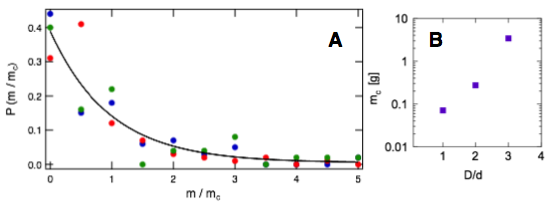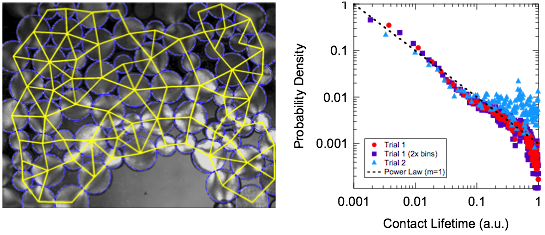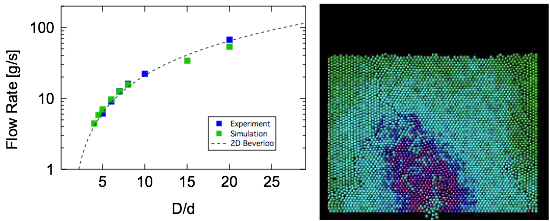Reports: UNI956888-UNI9: Dense Granular Flows: Connecting Dynamics across Scales
Kerstin Nordstrom, PhD, Mount Holyoke College
The aim of this research is to connect micro- and mesoscale dynamics to understand gravity-driven granular flow in a silo. To achieve this aim, we study two-dimensional analogues to three-dimensional systems for visualization. We use ultra-high speed video to track the events in real time. Lastly, we employ photoelastic particles and molecular dynamics simulations to measure the local forces.
In the past academic year, one undergraduate student (Emma Thackray) was working on measuring properties of a bidisperse photoelastic system. Briefly, the system has 2 phase behaviors, depending on the width of the bottom opening: a free-flowing state, and a state which will clog after some time. She has focused on understanding the clogging behavior. The baseline measurements for this line of inquiry are statistics of outflow events. That is, given a bottom opening size, how much mass on average will outflow before a clog forms?
While there is still more data to collect for ideal statistics, a summary of current results is in the figure below. Shown in plot A is the probability of a particular outflow size for outlet sizes 1d [n = 100 trials, blue], 2d [n = 100, red], and 3d [n = 50, green], where d is the size of a large particle. The data are fit to a decaying exponential, and normalized by the characteristic mass obtained in the fit. The exponential form suggests, in agreement with previous findings, that clogging can be modeled as a Poisson process. What is left to uncover is whether or not the characteristic mass diverges at some critical opening size, or if the characteristic mass increases without bound but exceeds any realistic measurement window (hence the observation of a free-flow regime).
We have also begun to dissect the particle-scale data in earnest, to investigate why there is a spread in avalanche sizes for a given opening size. By taking high-resolution data at 10,000 frames per second, we are able to track all particles in all frames. We have also developed a protocol for identifying the contact network in the system, as shown in the figure below (left). Here particles are outlined in blue and a yellow line connects the centers of particles in contact. This particular image is at the end of trial that has reached a clogged state. We are currently looking into 1) the arch geometries of permanent vs intermittent clogs, and 2) the evolution of the contact network approaching clog development. The figure below (right) shows the probability of contact lifetimes (all particles, not just near the opening) for two distinct trials with the same opening size, solely during the time before a clog forms. Trial 2 becomes clogged sooner, but even before it clogs, the contacts are longer-lived on average in trial 2, as shown in the figure. This may provide predictive power for the expected lifetime of an avalanche, which would have extremely high impact.
This past summer, with the help of PRF funds, three more undergraduate students started work on this project. One student (Ariel Kane-Esrig) was only around for the summer, and so contributed by writing code to calculate dynamical heterogeneities for tracked particle data. As one approaches the jamming or glass transition, one can see dynamical heterogeneities increase. We hypothesize there may be a similar phenomenon in the clogging transition.
Two students were directly assigned to investigate the free-flow state. One student (Grace Cai) set up LAMMPS molecular dynamics software in the lab, and is simulating many different initial conditions, including those directly related to experimental data. Shown below on the left is a plot of simulation and experimental data in the free-flowing system, indicating our success in capturing the correct microscopic physics. We have become interested in the role of sample preparation on the subsequent dynamics of the system, and are now varying this using different protocols. Additionally in this system, we are able to measure forces the particles experience, so this will be an interesting data stream to probe further. This ability is demonstrated in the figure below on the right, where the particle colors indicate the force on each particle during an outflow simulation.
The second student (Anna Belle Harada) is experimentally investigating large (approximately 10,000 particles) arrays of monodisperse spheres in free-flow. We are specifically interested in how the packing structure may or may not influence the flow rate (and ultimately will look into clogging statistics, too). In any event, the short timescales probed (10,000 frames per second) and sheer statistics produced by these tracks will be very interesting to dissect. Shown below is a visualization of real experimental data to demonstrate our tracking fidelity. The opening is at the bottom of the image, and each particle is colored randomly and represented by a circle.
In addition to personnel support, we were able to purchase a new simulation computer, new lenses for imaging, as well as various other supplies to help produce the experiments. We visited the Soft Matter Gordon Research Conference for one day with support from the grant.
We anticipate doing more precise experiments with photoelastic disks in the coming year, and so will use PRF funds to purchase further supplies for this work. We anticipate sending 1-2 students to the APS March Meeting this year using the PRF grant. Grace Cai and Emma Thackray are currently undergoing senior thesis work on their projects, so we anticipate great progress over the next year. For Emma's work, we have already the outline of a manuscript we wish to submit, and are spending the year filling in the gaps. Anna Belle Harada is also continuing her work as an independent study this year, and will hopefully pursue thesis work next year. Lastly, we will aim to hire at least three students to continue the work in the summer of 2018.















